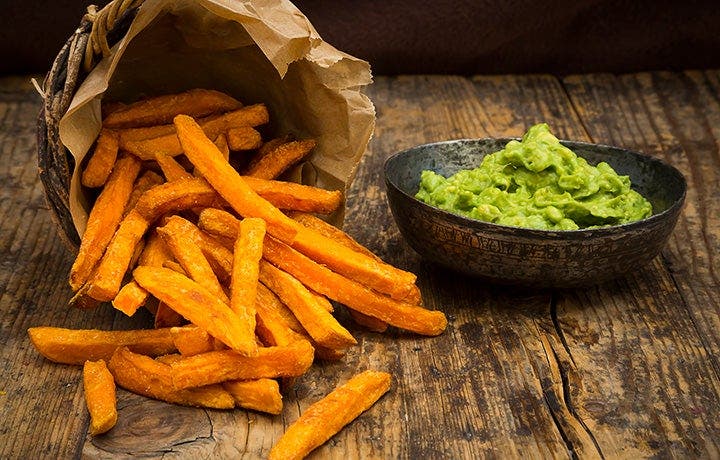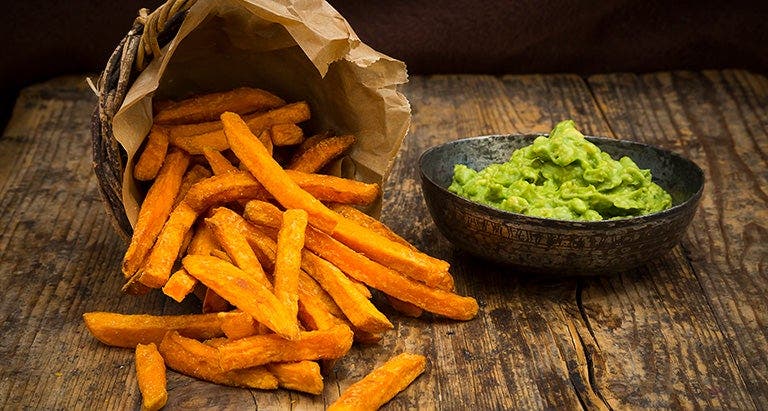The difference between healthy and unhealthy fats


In this article:
3/ Trans fats
5/ How much fat should I eat in a day?
6/ What's the deal with coconut oil?
7/ The bottom line
In the early ‘90s, “fat” suddenly became a bad word, leading to a boom in fat-free diets that weren’t actually all that healthy or supportive of weight loss. Nuts, for example, were verboten because they contain fat, but nutritionally void, fat-free carbs like soft pretzels were recommended instead. Thankfully, our understanding of the science evolved to paint a more nuanced picture of fats.
Now we know that fat is an essential part of a healthy diet — necessary for giving your body energy, helping your cells function, and absorbing some nutrients and hormones.
But that doesn’t mean doctors are recommending unlimited butter, burgers, and fries. That’s because the type of fat you eat is important, and some kinds are better for your health than others.
The WeightWatchers Points® Program accounts for this and guides you toward healthier fats by attributing lower Points values to better dietary fat sources. Here’s what else you need to know about the different kinds of fats:
Unsaturated fats
Unsaturated fats are beneficial. They can improve blood cholesterol levels, ease inflammation, and even stabilize heart rhythms.
There are two kinds of unsaturated fat (monounsaturated and polyunsaturated) and most foods contain a combination. Certain forms of polyunsaturated fat (omega-3 and omega-6) are important because our bodies don’t make them, so we need to get them from food.
Where you'll find them:
Monounsaturated fats are found in avocados, peanut butter, almonds, seeds including sesame and pumpkin seeds, and canola and olive oils. Polyunsaturated fats, including omega-3 fats, are present in fish, while plant sources include flax seeds, walnuts, and canola or soybean oil.
Saturated fats
The Dietary Guidelines for Americans recommends limiting saturated fat to less than 10% of our total daily calorie intake: It’s why foods higher in saturated fat are higher in Points. Replacing saturated fat with unsaturated fat can help you stick to your Points budget, not to mention there’s evidence that swapping polyunsaturated fat for saturated fat can lower your risk of heart disease. What’s the difference? Eating too much saturated fat increases your levels of LDL cholesterol — the harmful kind that’s linked to heart disease and strokes.
Where you’ll find them:
Pizza, cheese, whole and reduced fat milk, butter, ice cream, meat products (including sausage, bacon, beef, and hamburgers), cookies, cakes, and other grain-based desserts.
Trans fats
Your body doesn’t need trans fats, and they can increase damaging LDL cholesterol while simultaneously lowering beneficial HDL cholesterol, a double whammy for your body that’s linked to an increased risk of heart disease, the leading cause of death in the U.S. It used to be that manufacturers were allowed to add oils that contained trans fats to foods, but that’s been banned for several years. Now the main way people consume trans fats is from animal products, where they occur naturally in small amounts.
Where you’ll find them:
Milk, butter, cheese, and meat products (including sausage, bacon, beef, and hamburgers).
What’s better for limiting unhealthy fat — butter or margarine?
Butter
Butter contains saturated fat, and eating too much saturated fat increases your levels of LDL cholesterol — the harmful kind that’s linked to heart disease and strokes. That said, it’s OK to use small amounts and still have an overall healthy way of eating.
Margarine
Because margarine is made from a blend of mostly plant oils, it usually has less unhealthy saturated fat than butter. Since “most margarines are substantially lower in saturated fats than butter,” says physician Dr. Harriet Hall, M.D. It’s smart to check the margarine label and choose the one with the lowest amount of saturated fat.
Still, the more solid a margarine is, the more saturated fat it has, so avoid sticks of margarine when possible.
In short, it’s fine to use either margarine or butter — just make sure that if you go with butter, try to limit your amount, and if you’re using margarine, opt for the softer kind in the tub or squeeze tube instead of in stick form. Or better yet: Go with a fully unsaturated fat and dip your bread in olive oil instead.
How much fat should I eat in a day?
Remember that fat is necessary for a healthy body, since it helps with cell growth, hormone production, nutrient absorption, and heart health. But what kind of fat you’re eating matters just as much as the amount. Having the majority of the fats you eat coming from unsaturated fat is the healthiest way to go.
As for overall fat intake, the most recent Dietary Guidelines for Americans removed restrictions on total fat intake, but still emphasizes limiting saturated fat as part of overall healthy eating patterns; the recommendation is that no more than 10 percent of your total daily calories come from saturated fat.
Because foods higher in saturated fat are higher in Points and unsaturated fats lower a food’s Points value, WeightWatchers guides you towards a pattern of eating that’s lower in saturated fat. In other words, by sticking within your Points, you don’t have to do the math on saturated fat grams.
What's the deal with coconut oil?
Coconut oil contains the same amount of calories per tablespoon as olive oil. Yet unlike olive oil, it’s very high in the saturated fats you want to limit. In fact, coconut oil contains 82 percent saturated fat — much more than butter, which is 52 percent saturated fat.
Replacing oils that are high in saturated fat, like coconut oil, with oils high in unsaturated fat (like olive oil and rapeseed oil) is a healthier choice that can save you Points.
The bottom line
Fat shouldn’t be demonized — your body needs them. But shifting what kinds of fat you’re eating can boost your health. In short, try to limit your intake of saturated fats to less than 10% of your total daily calorie intake and to swap out saturated fats whenever you can for healthier unsaturated fats.
This content is for informational purposes only and does not constitute medical advice, diagnosis or treatment. It should not be regarded as a substitute for guidance from your healthcare provider.
Low-fat vs. low-carbohydrate diet: The Journal of the American Medical Association (2018). “Effect of Low-Fat vs Low-Carbohydrate Diet on 12-Month Weight Loss in Overweight Adults and the Association With Genotype Pattern or Insulin Secretion.” https://jamanetwork.com/journals/jama/fullarticle/2673150
